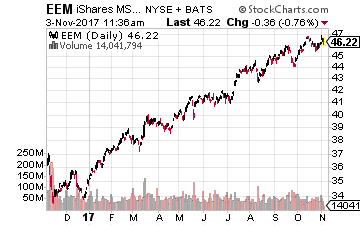One of the biggest changes to investing in recent times is the vast amount of choices available to investors of any size. The advent of ETFs has opened up markets and assets which almost no one could previously access – especially if you didn’t have a lot of money to invest.
It used to be you could invest in individual stocks, bonds, or mutual funds. Now, through ETFs, you can invest in everything from palladium to Thailand to foreign junk bonds. There are multiple ETFs available for a variety of strategies and investing philosophies as well (value, growth, income, etc.). Plus, these funds are available to just about anyone with a brokerage account.
The popularity of ETFs has also shined a light on asset class investing as a primary means of long-term/retirement strategies. Instead of just buying stock and bonds, many portfolios now are diversified into 10 to 15 (or more) asset classes, such as foreign government bonds, REITs, and commodities.
One of the most popular asset classes to invest in over the last decade has been emerging markets. This class includes countries like China, India, and Brazil. They tend to be countries which can experience high growth but also high risk (with China being the perfect example).
Related: 2 Stocks to Buy for the Death of the Combustion Engine
 With major US indexes at or near all-time highs, and valuations reaching very frothy levels, investors may be turning to emerging markets for growth in the final weeks of the year. In fact, iShares MSCI Emerging Market ETF (NYSE: EEM) is seeing some massive bullish activity in its options. EEM is the most popular emerging market fund and one of the most popular ETFs period.
With major US indexes at or near all-time highs, and valuations reaching very frothy levels, investors may be turning to emerging markets for growth in the final weeks of the year. In fact, iShares MSCI Emerging Market ETF (NYSE: EEM) is seeing some massive bullish activity in its options. EEM is the most popular emerging market fund and one of the most popular ETFs period.
This past week, a trader made a gigantic bullish bet in EEM options expiring on December 15th. This three-way trade involved buying a call spread and partially financing it by selling puts. (By the way, that’s one of my favorite options strategies, but you have to a sizeable margin account to do it because of the naked short puts.)
With EEM at $46.75, the trader purchased the December 15th 47-48.50 call spread 102,000 times, while simultaneously selling 102,000 of the 44.5 puts in the same expiration. Normally, the call spread would cost $0.58, but selling the puts for $0.33 brought the total spread cost down to $0.25.
With a total cost of $0.25, the breakeven point for the trade is $47.25 and max gain is at $48.50. The dollar gain at $48.50 would be a whopping $12.75 million. On the flip side, if EEM closes below $47 on December 15th, the trade would cost $2.55 million (in premium spent) down to $44.50. Below $44.50, the loss potential rises as the price goes lower.
Of course, EEM isn’t an especially volatile ETF, so the chance of it plunging below $44.50 in the next 6 weeks is extremely low. Still, this is clearly a lot of money to bet on EEM going up. Losing $2.5 million if the ETF does nothing between now and then is a real possibility.
The trader likely believes investors will be looking at emerging markets to close out the year. Perhaps some in the investment community believe the US and other developed nations have peaked for the year.
Regardless, if you like the idea of taking a low risk bet on EEM, you can simply replicate the call spread portion of the trade. Since most investors won’t be trading 100,000-lots, paying $0.58 for $0.92 in upside is a perfectly reasonable thing to do.
[FREE REPORT] Options Income Blueprint: 3 Proven Strategies to Earn More Cash Today Discover how to grab $577 to $2,175 every 7 days even if you have a small brokerage account or little experience... And it's as simple as using these 3 proven trading strategies for earning extra cash. They’re revealed in my new ebook, Options Income Blueprint: 3 Proven Strategies to Earn Extra Cash Today. You can get it right now absolutely FREE. Click here right now for your free copy and to start pulling in up to $2,175 in extra income every week.